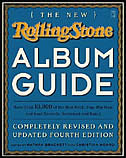| Working Drafts and Notes For: [The New] Rolling Stone Album Guide |
 |
Hank Williams
| 40 Greatest Hits (Mercury, 1978) | |
| Rare Demos: First to Last (Country Music Foundation, 1990 | |
| The Original Singles Collection . . . Plus (Mercury, 1992) | |
| Alone and Forsaken (Mercury, 1995) | |
| Low Down Blues (Mercury, 1996) | |
| The Complete Hank Williams (Mercury, 1998) | |
| Alone With His Guitar (Mercury, 2000) | |
| Beyond the Sunset (Mercury, 2001) | |
| The Ultimate Collection (Universal, 2002) |
Hank Williams lived fast, died young, and left a beautiful memory. He was born in Alabama in 1923, and died less than thirty years later, having recorded 36 top-ten country and western singles in less than six years. He wrote over two thirds of those songs, leaving one of the major songbooks in American music. But it was Williams' performance that had the most immediate impact, virtually defining the hard, spare style of modern country music that took its name from his early hit, "Honky Tonkin'."
Williams had an extraordinary ability to convey naked emotion. He could be exuberant, but more often he played sad, lonesome, dejected, defeated, down right miserable. For every "Hey, Good Lookin'" there's a whole mess of "I'm So Lonesome I Could Cry" and "Moanin' the Blues" and "Alone and Forsaken" and "I'll Never Get Out of This World Alive." Even his love songs portray a man hopelessly out of control, from the lovestruck "Howlin' at the Moon" to the hopeful "Half as Much" to the troubled "I Can't Help It If I'm Still in Love With You" to the frazzled "Please Make Up Your Mind" to the hopeless "You Win Again." It's easy to take these as clues to Williams' own doomed life, and it doesn't seem accidental that Williams finalized his second (and last) divorce from Miss Audrey with the vicious "Your Cheatin' Heart." But not everything Williams did was first person: "Kaw-Liga" chronicled a heartsick piece of knotty pine.
After Williams' death, his recorded legacy was looted and plundered for spurious singles, fake stereo, and even overdubbed duets and trios with his progeny. But in the CD era there started a systematic effort to restore the original recordings and round up as much trivia as possible. The remastering of 40 Greatest Hits went back to the original mono tapes and 78 rpm discs, including only one overdubbed single. Then came The Original Singles Collection . . . Plus, which filled two-and-a-half CDs with original singles, then filled out the third CD with the undubbed demo sources for the posthumous singles. While 40 Greatest Hits is an impeccable selection, the extra material in Original Singles gives a much fuller accounting of Williams' work.
Then came The Complete Hank Williams, a sprawling ten CD box with four CDs of studio recordings in chronological order, followed by six CDs of song demos, radio programs, and live recordings. The studio recordings add 22 cuts to Original Singles: the spoken lectures released as Luke the Drifter (collected separately in Beyond the Sunset), gospel songs sung with wife Audrey, and a few alternate takes, but hardly anything that could be called a miss. The other six CDs have their moments, but the early Montgomery demos are very scratchy, the demo songs tend to be lackluster, and the live material is sometimes marred by bad sound and too much patter. The Shreveport Radio Performances tend to be better performances. So overall, the box is too much.
The other anthologies slice this work up in various ways. Low Down Blues and Alone and Forsaken take an almost perverse delight in Williams' lowest-down material, and therefore overlap quite a bit. Rare Demos originally uncovered many of the song demos, concentrating on the earliest and roughest. Alone With My Guitar also selects from the demos, much more expertly. The Ultimate Collection is the latest attempt to sum up Williams in 2 CDs: the main difference between it and 40 Greatest Hits is that is selected more broadly from the box, including demos and live cuts instead of sticking to the studio singles. And in that it may have a slight edge, presenting a more complex and rounded portrait of a singer who was much more than "just another guy on the lost highway."
Notes
Other releases:
| Rare Demos: First to Last (Country Music Foundation, 1990 | |
| 20 of Hank Williams' Greatest Hits (Mercury, 1990) | |
| Health and Happiness Shows (Mercury, 1992) | |
| Live at the Grand Ole Opry (Mercury, 1999) | |
| 20th Century Masters: The Millennium Collection (Mercury, 1999) | |
| The Blues Come Around (Catfish, 2001) | |
| I Saw the Light (Mercury, 2001) | |
| Lovesick Blues (ASV, 2001) | |
| Hillbilly Hero (Proper, 2002) |